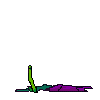|
|
!!!Welcome !!! |
|
||||||||||||||
 |
Achondroplasia is the most common form of disproportionate short stature.[1] The diagnosis is based on very specific features on the radiographs, which include a contracted base of the skull, a square shape to the pelvis with a small sacrosciatic notch, short pedicles of the vertebrae, rhizomelic (proximal) shortening of the long bones, trident hands, a normal length trunk, proximal femoral radiolucency, and, by mid-childhood, a characteristic chevron shape of the distal femoral epiphysis. Hypochondroplasia and thanatophoric dysplasia are part of the differential diagnosis, but Achondroplasia can be distinguished from these because the changes in hypochondroplasia are milder and the changes in thanatophoric dysplasia are much more severe and invariably lethal. Achondroplasia is an autosomal dominant disorder, but approximately 75% of cases represent new dominant mutations. The gene for Achondroplasia has recently been found. Achondroplasia is due to a change in the genetic information for fibroblast growth factor receptor 3.[2,3] Almost all of the mutations have been found to occur in exactly the same spot. Now that the gene has been found and the mutation known, potential therapies and diagnostic methodologies are likely to be developed. A great deal is known about the natural history of the disorder that can be shared with the family. The average adult height in Achondroplasia is about 4 ft for both men and women Other features include disproportionate short stature, with shortening of the proximal segment of the limbs, a prominent forehead, a flattened midface, and an average-sized trunk. The head usually appears relatively large compared with the body. The most common complication, occurring in adulthood, is related to lumbosacral spinal stenosis with compression of the spinal cord or nerve roots. This complication is usually treatable by surgical decompression, if diagnosed at an early stage.
Pseudoachondroplasia: Pseudoachondroplasia, a short-limbed dwarfism, is inherited in an autosomal dominant fashion. Clinically, it has little resemblance to Achondroplasia.
THE PRENATAL VISIT
The diagnosis of Achondroplasia in the fetus is most often only made with certainty when one or both parents have this condition. In this circumstance the parents are usually knowledgeable about the disorder, the inheritance, and the prognosis for the offspring. In most situations in which the parents have normal stature, the diagnosis may only be suspected based on the observation of disproportionately short limbs in the fetus by ultrasound. With the frequent use of ultrasound, approximately one third of cases of fetal Achondroplasia are suspected prenatal. However, disproportionately short limbs are observed in a heterogeneous group of conditions. In the majority of these cases, the specific diagnosis cannot be made with certainty except by radiography late in pregnancy or more usually after birth. In these cases, caution should be exercised when counseling the family. In those infrequent cases in which the diagnosis is unequivocally established either because of the familial nature of the disorder or by prenatal radiography, the pediatrician may discuss the following issues as appropriate. 1. Review, confirm, and demonstrate laboratory or imaging studies leading to the diagnosis. 2. Explain the mechanisms for occurrence or recurrence of Achondroplasia in the fetus and the recurrence risk for the family. 3. At least 75% of cases of Achondroplasia occur in families in which both parents have average stature and Achondroplasia in the offspring occurs due to sporadic mutation in the gene. 4. Review the natural history and manifestations of Achondroplasia, including variability.[1] 5. Discuss further studies that should be done, particularly those to confirm the diagnosis in the newborn period. If miscarriage, stillbirth, or termination occurs, confirmation of diagnosis is important for counseling family members about recurrence. 6. Review the currently available treatments and interventions. This discussion needs to include the efficacy, complications, side effects, costs, and other burdens of these treatments. Discuss possible future treatments and interventions. 7. Explore the options available to the family for the management and rearing of the child using a nondirective approach. In cases of early prenatal diagnosis, these may include discussion of pregnancy termination, as well as continuation of pregnancy and rearing of the affected child at home, foster care, or adoption. When both parents are of disproportionate short stature, the possibility of double heterozygosity or homozygosity for Achondroplasia must be assessed. Infants with homozygous Achondroplasia usually are either stillborn or die shortly after birth. Homozygous Achondroplasia can usually be diagnosed prenatally. 8. If
the mother is affected with Achondroplasia, a cesarean section must
be performed because of a small pelvis.[9] This surgical procedure
usually involves general anesthesia because of the mother's spinal
stenosis and the consequent risk associated with conduction (spinal/epidural)
anesthesia. A mother affected with Achondroplasia may develop respiratory
compromise in the third trimester of pregnancy, so baseline pulmonary
function studies should be done. A pregnancy at risk for homozygosity
should be followed with ultrasound measurements at 14, 16, 18, 22,
and 32 weeks of gestation in order to distinguish homozygosity or
heterozygosity from normal growth patterns in the the fetus. New
DNA diagnostic studies are likely to become available
|
 |
||||||||||||
More Expression Web templates
|
||||||||||||||
|
Copyright Achondroplasia UK. All Rights Reserved www.achondroplasia.co.uk |
||||||||||||||

